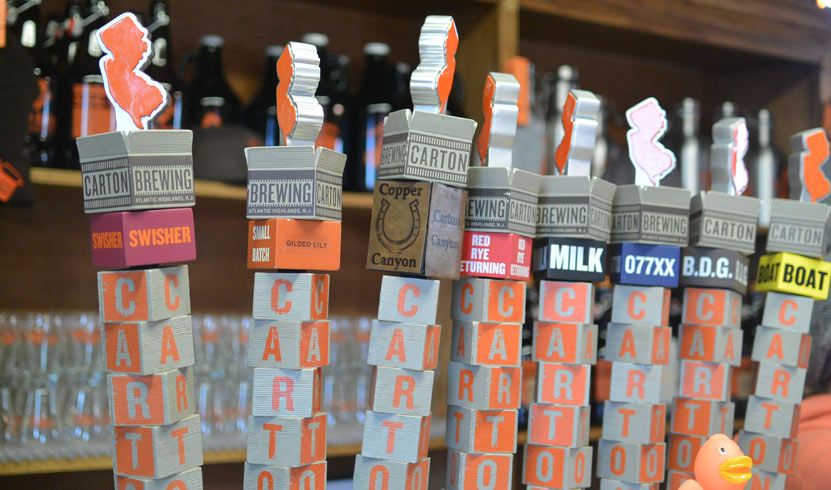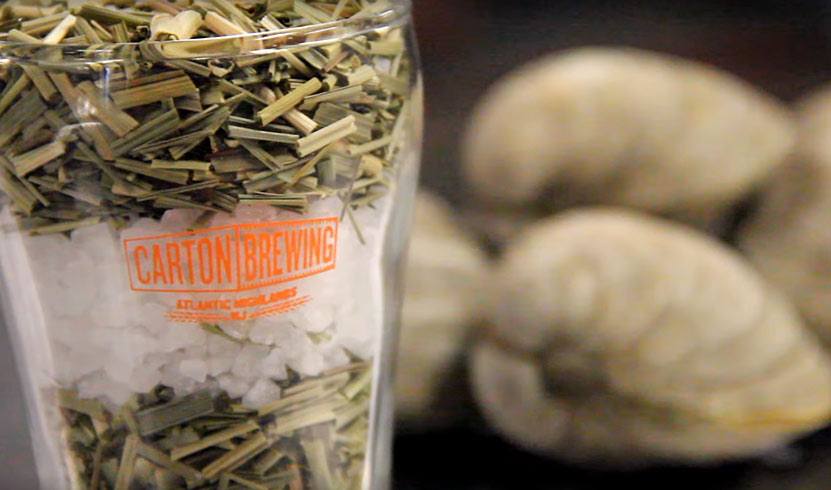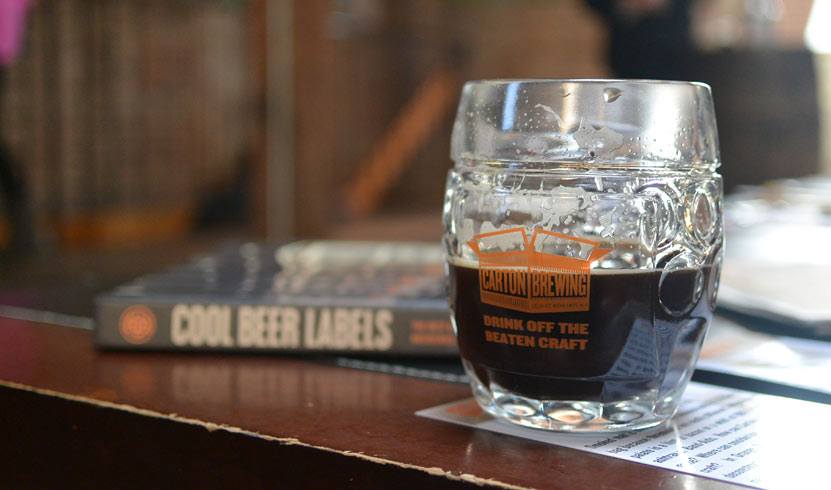With two new breweries opening every day in the United States, it can be hard to find one doing something unique. That’s why we’ve been fans of Carton Brewing since they opened their doors five years ago. While they offer a great Double IPA and an exceptional sessionable pale, they also make a beer that tastes like trail mix, one made with a dry rub, and another brewed with astronaut ice cream. And they’re all really good.
We sat down with Augie Carton, one of the founders of Carton Brewing, to find out where these wild ideas come from, what’s the strangest ingredient he’s brewed with, and how the hell you brew a beer that tastes like a salad.

 Carton brews a lot of beers that seem inspired by food. What made this a focus of yours?
Carton brews a lot of beers that seem inspired by food. What made this a focus of yours?
AC: There is commonality and crossover in flavors all over the spectrum. You know how some coffee, some marijuana, some chocolate, some fruits, some hops and some rodents all share a skunky smell, and how you can also find a cherry aroma in all of those (except the rodent)? It’s not that we focus on these things as much as it is that this is where our inspiration comes from.
Smelling figs in the way a malt called Special B and Belgian Candi Sugar combine in a Quad after having figs with Daniel Humm’s roast duck led to Decoy. Enjoying the aromatics of Thai chili peppers and saffron in Neil Perry’s shrimp broth led to Tharsis because our saison yeast reminds me of flowers and peppers. Panzanella was born from explaining how Summit hops taste like onions and garlic, but like in a salad, not a stir-fry. And honestly, Regular Coffee was just born of petulance because good stouts can taste enough like coffee that adding coffee is more obvious than inspired, so we looked for a beer that couldn’t taste anything like coffee and tried to build it into a thing where the coffee made sense in spite of itself.
 Is it a challenge recreating some of these flavors while still crafting a beer that tastes good?
Is it a challenge recreating some of these flavors while still crafting a beer that tastes good?
AC:There is a current trend in brewing of making things taste exactly like other things. It’s how root beer-flavored malt drinks snuck into the public conscience as beers; that is not what Carton does. We are often just taking a flavor that exists in a beer and teasing it further in a direction it was already going. Our beers should taste like beers and…
A beer like Rub takes a lot of tinkering. The beer is meant to taste like the porter you drink when you sit down after a day of barbecuing and feasting on smoked meats. Rich, but not so rich it’s inappropriate for warm weather, with touches of smoke and that mélange of garlic, cayenne, chocolate, coffee, black pepper, onions, and so on. They all need to be there and they need to stick out individually yet mix. An eighth of a teaspoon of cumin shows incredibly different when considered along with sugar, and it moves, the smallest amount, a couple degrees Plato, so we do it a bunch of ways and dial it to where we want it.

 Are there any you’re particularly proud of?
Are there any you’re particularly proud of?
AC: For Digger we built a small pale for the height of summer drinking and added clams, lemongrass, and salt. The beer doesn’t taste just like any of those but, rather, after a half dozen of them you are left with the lingering flavors of a day enjoyed on a Jersey beach in mid-July, reveling while drinking inconsequential beers and snacking on local fare. It is strange in today’s craft world to strive for inconsequential, but Digger evokes the best of evenings mostly in its ability to stay out of the way while being persistent in its intent.
 Conversely, there have to be some ideas you’ve had for a beer that the public didn’t get to try because you weren’t happy with the results. Any stick out to you?
Conversely, there have to be some ideas you’ve had for a beer that the public didn’t get to try because you weren’t happy with the results. Any stick out to you?
AC: We develop our beers on a small brew system we call The Tippy. Sometimes we get what we want on the first try and sometimes it’s more than 10 tweaks. There are some we don’t have where we want them just yet, but there are none we have completely given up on.
 What’s the weirdest ingredient you’ve tried brewing with?
What’s the weirdest ingredient you’ve tried brewing with?
AC: Right now it’s cherry blossoms. They are a most delicate flavor, and playing with a brew that shows them well and preserves their prettiness takes effort. Fresh cherry blossoms last moments, so to preserve them they are traditionally packed in salt and plum vinegar. Taking a cue from this we went with a small, salted sour ale, which we lightened and dried by adding sushi rice to the malts in the mash. It’s just right for the humid summer doldrums. In the past it has been white truffles, wasabi root, butter, and so on. Really, “weird” is in the eyes of the beer-holder.
 Is there an idea for a beer you’ve had for some time but haven’t had the chance to brew?
Is there an idea for a beer you’ve had for some time but haven’t had the chance to brew?
AC: There are probably 100 beers we will get to when capacity allows. For now, the filter is what is exciting us most. The natural selection in the brew house is enthusiasm, which is funny because if we have a fun, simple beer, let’s say an IPA using a new hop, it is left sitting on paper while we try to figure out how to do something we aren’t necessarily sure we will like more.
Different pleasures with different satisfactions, but we get to every beer we want to do because after the pleasure of ticking all the flavor boxes involved in something like Rub, we like to put the geeky flavor brain on hold and settle into the very base enjoyment of a heady bombed-out IPA.

 Which is more rewarding: Brewing a beer that’s appropriate to its style and really good or brewing something completely unique?
Which is more rewarding: Brewing a beer that’s appropriate to its style and really good or brewing something completely unique?
AC: The satisfaction for us is in the engagement with people that get it regarding flavor. Beers like Dub are great because they start an interaction with a certain group of enthusiastic craft drinkers, while beers like Pumpkin Cream Ale draw out certain types of foodies. The excitement for us comes from finding ways to take this conversation from three points to a million, that’s where we find we learn the most to bring back to the Tippy.
Building a simple chocolate flavor into a small stout so that when we dry hop it with rose petals it smells like cheap chocolate and roses but tastes like stout is a different type of reward; often we are far more pleased with accomplishing something challenging, even though there is no doubt the hedonistic satisfaction of a bomb IPA we know how to do will make all of us happy.
 Last one: What’s your go-to summer beer and why?
Last one: What’s your go-to summer beer and why?
AC: Boat, because Boat is the best beer in the world ☺




